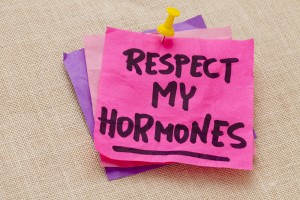Estrogen Metabolism

I previously discussed human estrogens and touched on synthetic estrogens. Part of the problem with synthetic and equine estrogens is that they tend to be metabolized differently. Hopefully, I’ll be able to convey some of the issues involved with this stuff.
Estrogens are metabolized in 2 phases: Phase 1 (hydroxylation) and Phase 2 (methylation) detoxification.
Additionally, there are 3 different pathways by which the detoxification can occur. We’ll start with the optimal pathway.
2-Hydroxy
Estradiol and estrone both go through the same metabolic pathways. The ‘2’ pathway is optimal as it has the lowest risk for cancers and other problems.
You’ll notice from the pathway above that Estrone is converted to 2-Hydroxyestrone (step 1 in the diagram). This is Phase I detoxification also known as hydroxylation.
Step 2 in the diagram depicts Phase 2 detoxification which is also known as methylation. This step takes a more toxic substance and alters it to prepare it for elimination. If methylation is not working well then we can have elevated levels of 2-OHE1 (and 2-OHE2).
2-OHE1 (2-hydroxyestrone) is considered a ‘good estrogen’ and it does not stimulate cell growth. It can block the action of stronger, potentially carcinogenic estrogens. When it is methylated to 2-MeE1 it is cancer protective. Measuring the 2-OHE1:2-MeE1 ratio is a good indicator of the body’s ability to methylate. Interestingly, low 2:16 ratio is also associated with an increased rate of developing lupus.
Moderate exercise, high-protein diets, and the supplements listed below have all been shown to raise 2-OHE1 levels.
16-Hydroxy
Another potential pathway through which estrogen is metabolized is the ’16’ pathway. This pathway, while needed, is not as desirable as the 2-Hydroxyestrone pathway.
Step 1 in the 16-Hydroxyestrone pathway is the same. It is a hydroxylation, Phase I detox. However, Phase 2 is a reduction phase and produces Estriol. Recall that estriol (E3) is a very weak estrogen.
16-OHE1 has significant estrogenic activity and studies show it may be associated with an increased risk of breast cancer. Higher levels are associated with obesity, hypothyroidism, pesticide toxicity (organochlorines), too much Omega-6 fatty acids, and inflammatory cytokines.
4-Hydroxy
The 3rd possible metabolism pathway is the 4-Hydroxyestrone pathway. This pathway is the most problematic and we want to limit estrogen metabolism through the 4-OH pathway as much as possible.
Here we have estrone being hydroxylated through Phase 1 detox and forming 4-OHE1. Step 2 is methylation of 4-OHE1 to form 4-MeE1. When 4-OHE1 is properly methylated to 4-MeE1 it is relatively benign as the 4-MeE1 is easily eliminated and risks are low.
The problem starts when methylation is inadequate as there begins to be a buildup of 4-OHE1. 4-OHE1 can then be converted to 3,4-Quinones which are pro-carcinogenic meaning that they cause cancer. That is bad news!
4-OHE1 may directly damage DNA and cause mutations which enhances cancer development. Equine estrogens increase estrogen metabolism into 4-OHE1. Women with uterine fibroids may have increased levels of 4-OHE1.
Antioxidant support is a great idea to try to limit these nasty chemicals. Consider supplements such as:
- Vitamin E
- Vitamin A
- Vitamin C
- Beta-carotene
- Selenium
- Curcumin
- N-acetylcysteine (NAC)
- Green tea catechins (polyphenols)
- Lycopene
- Alpha-Lipoic Acid (ALA)
- Flavonoids
- S-acetyl Glutathione
Measure Your Estrogen Metabolites
Fortunately, we are able measure each of these hormones in our patients. We can measure the individual estrogens as well as the hydroxy and methoxy metabolites. We can, therefore, better assess our patient’s risks for developing cancer and having other issues associated with poor estrogen metabolism.
We test these hormones through a urine test. We can also check homocysteine levels and we assess MTHFR status as well. These can also help guide us in the appropriate management of hormone metabolism.
How To Improve Estrogen Metabolism
We’ve determined that there are healthy estrogen metabolism pathways and less healthy pathways. So, what can we do about it?
There are a variety of substances that influence the way your estrogens are metabolized. Some are toxins that increase the unhealthy estrogen metabolic pathways and supplements and foods that induce more healthy estrogen metabolism pathways. This applies to men and women as the pathways are the same for both.
Toxins:
- Xenoestrogens – natural or synthetic chemical compounds with estrogenic activity. Chemicals such as polychlorinated biphenyls (PCBs), bisphenol A (BPA), and phthalates are xenoestrogens. These chemicals disrupt normal estrogenic balance. You want to eliminate these chemicals from your environment. You may also consider a supplement which helps eliminate these chemicals from your body. Read more about this anti-xenoestrogen supplement here. Oh, and don’t forget about the hormones in a lot of the meat we tend to eat. Yet another reason to get natural, hormone free, or organic meats.
- Equine Estrogens – tend to favor the 4-OHE1 pathway. Combine them with a methylation deficiency and you have a potential problem.
Good Stuff:
- Diindolylmethane (DIM) – a metabolite of indole-3-carbinol (I3C). DIM increases the 2-hydroxylation of estrogens favoring the more healthy metabolic pathway. Read more about DIM as a supplement here. The goal dose is 200-300mg per day.
- Flax – you want the whole flax seed, not just the oil. It is the lignans in flax that help with estrogen metabolism.
- Kudzu – this herb has some phytoestrogenic effects.
- Sulfuraphane Glucosinolate (SGS) – supports Phase 2 detox as well as decreases the formation of 3,4-quinones. Read more about sulfuraphane here.
- Hormone Protect is one of our supplements that contains both sulfuraphane glucosinolate (SGS) and Diindolylmethane (DIM).
- Omega-3 Fatty Acids
- B6, B12, Folate
- MTHF
- TMG
- Rosemary
- Tumeric
- Weight Loss
References
- http://www.ncbi.nlm.nih.gov/pubmed/16411670
- http://www.pnas.org/content/94/20/10937.long
- http://www.ncbi.nlm.nih.gov/pubmed/14749240









